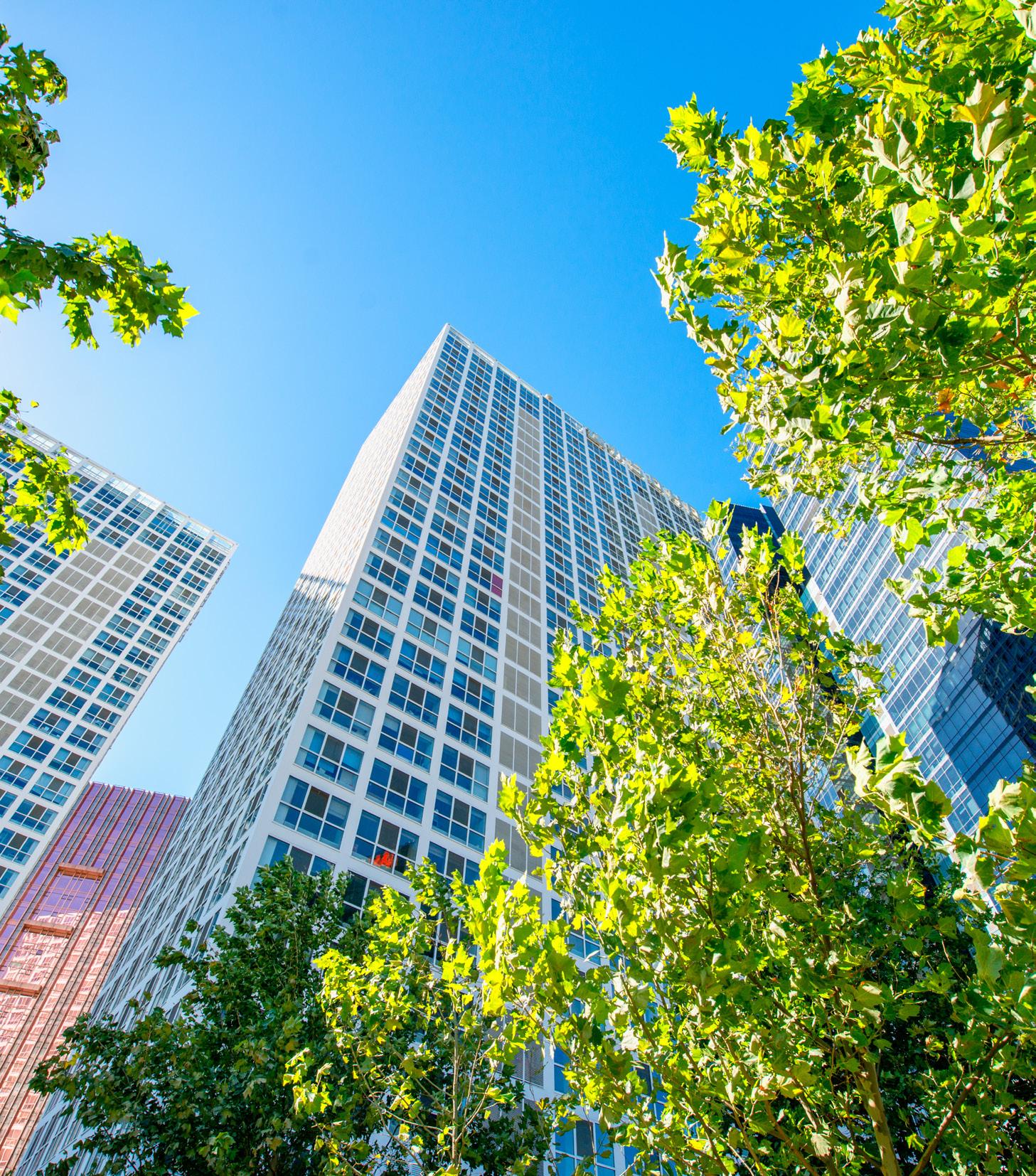
7 minute read
CLIMATE CHANGE, COVID-19, GREENER BUILDINGS AND PROPERTY INVESTMENT
from PMG ThinkBook
by PMG Funds
COMMERCIAL PROPERTY
WHAT’S OUR ROLE AND WHO SHOULD PAY?
Advertisement

INTERVIEW WITH NEW ZEALAND GREEN BUILDING COUNCIL CEO ANDREW EAGLES
Everybody loves green buildings! International research has shown that 95% of occupants want to live and work in green buildings, and the companies and landlords that want to attract these tenants are building greener to match demand 1 . However, there are still a substantial number of buildings in New Zealand that were built well before sustainability was a priority for the industry.
1 https://www.nzgbc.org.nz/Attachment?Action=Download&Attachment_id=2353
With our built environment creating upwards of 20% of New Zealand’s carbon emissions 2 , the questions for property investors become: what should our role be in helping to improve the sustainability of these buildings? What can we do to speed up New Zealand’s progress when it comes to making our existing building stock greener, and who should pay for it? At PMG, this is an issue that we have been wrestling with for a long time. As environmentally conscious individuals and responsible property funds managers, we are highly aware of the responsibility we have to drive forward sustainability within our portfolio, not only to support the environment but to maintain the quality and 'shelf life', and improve the value of the properties in our portfolio for investors. But we also face the age-old challenge of balancing out the costs that come with making the shift to ‘greening’ existing buildings. This question is one that has been top of mind for the team at the New Zealand Green Building Council (NZGBC) for the past two decades, and the progress that has been made in that time in developing solutions is significant. We spoke with current NZGBC CEO Andrew Eagles to learn more about the increasing momentum that’s taking place around green building in New Zealand right now, and how both investors and tenants can collaborate to improve the sustainability of property portfolios across the industry. On the day we met with Andrew Eagles in January 2020, he had just come from a meeting with the NZ Prime Minister and several key ministers, where they discussed the new $12b infrastructure package announced by the Government that morning. Included in the infrastructure package was a firm commitment from Government to building healthy, energy-efficient buildings, including a $200m allocation towards greening the public sector estate, among many other commitments. At the time, Eagles was obviously pleased with the commitments, and that the idea of green building had resonated at the highest levels in New Zealand with bipartisan support.


2 https://www.nzgbc.org.nz/Attachment?Action=Download&Attachment_id=2635

However, with the increased economic uncertainty that New Zealand is now facing in the wake of the global COVID-19 pandemic, he recognises that implementation will be one of the key challenges the industry will face in the future.
“To have greener buildings enshrined in NZ law is a huge step forward, but it’s just one part of the journey. Property investors still need to step up and find out where their buildings currently sit on the green spectrum and work towards improvements,” he says. “Increasingly, indexes will be used to assess which portfolios are taking this seriously compared with others.”
Go back two decades and green building was a fledgling concept in New Zealand. Some key new buildings were being designed, but the newly formed NZGBC in those days struggled to break through wider industry perception that green building was too difficult and overly expensive, all while working through the complexities of creating rating tools applicable to New Zealand’s unique conditions.
Eagles says the most tangible change that occurred in the intervening years was the conscious commitments from investors and developers to verifying the green performance of their building stock, encouraged by the establishment and improvement of rating tools like Green Star and NABERSNZ. “Since the introduction of Green Star in 2007, the NZGBC has been successful in mainstreaming the rating tool for commercial office buildings in New Zealand’s main centres to the point where today, over 80% of new commercial office buildings in the Auckland CBD are Green Star rated,” he says. Now, following the passing of the zero carbon bill in November 2019, he says interest in green building has heightened, especially as there are deadlines for meeting zero carbon targets. “Many investors today are rightly seeing high carbon as a risky investment. Unhealthy buildings with high running costs and high carbon are not a good look, nor attractive to tenants. Green building then is ultimately about saving money and creating a better return on investment.” Eagles cites a notable example from Australia, where research showed that the move to higher NABERS ratings in the Australian office building stock saved businesses $750m.
In relation to New Zealand’s zero carbon act, NZGBC’s specific request to building owners is that they start certifying their existing buildings to zero carbon in 2020, and to have all their buildings zero carbon by 2030.
Similarly, they are asking developers to build their new buildings to zero carbon and 20% less embodied carbon by 2025. They’re also asking tenants to inform their landlords in 2020 that they will be seeking zero carbon rated buildings in their leases by 2025.
“Property investors need to realise that this issue is not going away. The unequivocal global scientific consensus is that climate change is coming like a freight train, and the window for addressing it is getting smaller all the time. Plus, with our buildings responsible for 20% of NZ’s greenhouse gas emissions, it’s crucial that we address this through our built environment.
“There are benefits to investors for improving the environmental impact of their investments. Increasingly, buyers are seeking greener buildings, which raises the value of these properties, they
are cheaper to run so attract tenants with lower operating budgets and, in time, will be a requirement by Government anyway.”
Eagles has one key message for investors who are wanting to make their buildings greener: it’s time to collaborate.
“The fact is, it’s never been easier for property investors to get started on the journey towards greening their buildings. The first step is understanding where your portfolio sits on the green spectrum. If you have an office building that is over 1000 square metres, get it NABERSNZ rated. It’s a relatively low cost to do, and you’ll then have a very real sense of where you sit on the scale,” says Eagles.
“Maybe your building will only be two stars, but at least you’ll know, and you won’t need to publicise that – but it will mean you have a starting point to then plan and improve things.
“Another thing to realise is that if you have a Government tenant, they are going to be seeking ratings with your lease renewal, so now is the time to start addressing it. Basically, start understanding your building stock, before you’re embarrassed by it,” says Eagles.
“What’s helpful is that we have now introduced a rating tool, Green Star Performance, which can be applied to any building type, so we can rate retail, industrial, convention centres and others by the same measure. Having been through a health crisis,

tenants are going to be really interested in the health of their building. The potential of slower economic activity will heighten their interest in saving on bills. Greener buildings deliver healthy buildings that cost less to run.
“Remember, NZGBC is here to help. Costs for building green are down, our rating tools are better today than they have ever been, and there are many case studies and examples that we can share with investors to demonstrate the pathway to maximising their return on investment in green building,” he says.
“It just makes sense, and the ultimate result is you’ll have happier, healthier tenants. So, start the journey today, or risk being left behind.”












